Perennial bushes are woody plants that return year after year. The term “bush” commonly refers to deciduous shrubs with full canopies that extend to the ground. Many perennial bushes produce a seasonal flush of showy blooms while others are better known for their striking foliage. We’ve rounded up some of the best perennial bushes for adding style and charm to Southern gardens.
Flowering perennial bushes often play an outsized role in gardens, adding a burst of color during their peak season. Make the most of these performances by giving flowering shrubs a prominent place in the garden. Bushes with dramatic foliage can play a supporting role as background texture or can be massed for high impact in planting beds. Many bushy shrubs can also be grown in pots to produce a lush, standalone container planting.
Lime Sizzler™ Firebush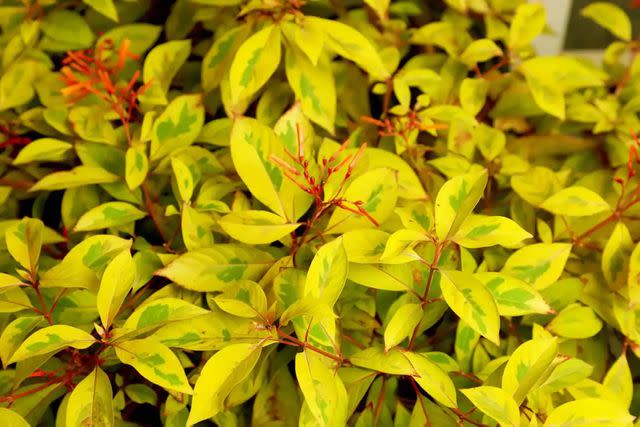
Southern Living Plant Collection
Botanical Name: Hamelia patens ‘Grelmsiz’
Soil Type: Moist, well-draining, rich
Soil pH: Acidic to alkaline (5.5-8.2)
USDA Hardiness Zones: 9 to 11
A radiant variety of firebush, Lime Sizzler™ ignites the garden all season long with golden foliage accented in green. Clusters of fiery red-orange blooms add to the display, covering plants from late spring through fall. Autumn brings a shift in foliage color as yellow leaves take on rich, coopery-orange hues. This Florida native is cold hardy to 20°F and can be overwintered indoors in cooler regions.
Hardy Hibiscus
Getty Images
Botanical Name: Hibiscus hybrids
Soil Type: Medium to wet, well-draining, average
Soil pH: Slightly acidic to neutral (5.5-7.5)
USDA Hardiness Zones: 4 to 9
Hardy hibiscus plants steal the spotlight when they come into bloom each summer with flowers reaching up to 10 inches wide! The bold pink, red, purple, white, or bicolor blooms are rich in nectar and attract hummingbirds, butterflies, and other pollinators. Hardy hibiscus plants are bred from a variety of species native to the Southeast, making them well suited to our hot and humid gardens. Plants have larger foliage and bigger blooms than their tropical counterparts and are winter hardy.
Beautybush
Botanical Name: Kolkwitzia amabilis
Sun Exposure: Full sun to part shade
Soil Type: Medium, well-draining, average fertility
Soil pH: Adaptable (6.0-8.0)
USDA Hardiness Zones: 4 to 9
Make a statement in the garden with this stunning deciduous shrub. Beautybush grows up to ten feet tall, developing a large flowing crown of gracefully arching branches that bend back toward the ground. Plants produce masses of bell-shaped pink blooms in spring. Some varieties boast gorgeous chartreuse foliage, while others have been bred for larger blooms or a more compact size. All perform beautifully as an accent or showy backdrop in mixed borders.
Suntastic™ Abelias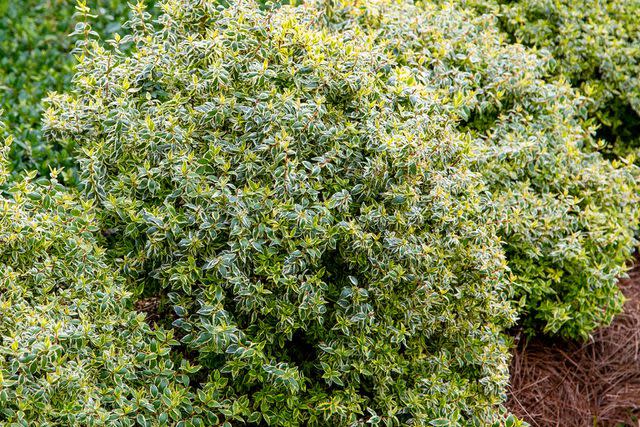
Southern Living Plant Collection
Botanical Name: Abelia hybrids
Sun Exposure: Full sun to part shade
Soil Type: Medium, well-draining, average
Soil pH: Adaptable (6.0-8.0)
USDA Hardiness Zones: 6 to 10
The Suntastic™ series of abelias brings new foliage colors and an improved growth habit to this already amazing groups of flowering shrubs. Three stellar varieties are available featuring creamy variegated foliage that takes on yellow, pink, or peach tints throughout the season. Each variety boasts fragrant white blooms visited by butterflies, bumblebees, and hummingbirds. Suntastic™ abelias develop a full, yet compact canopy that requires little pruning. A handsome shrub with year-round appeal.
Rose of Sharon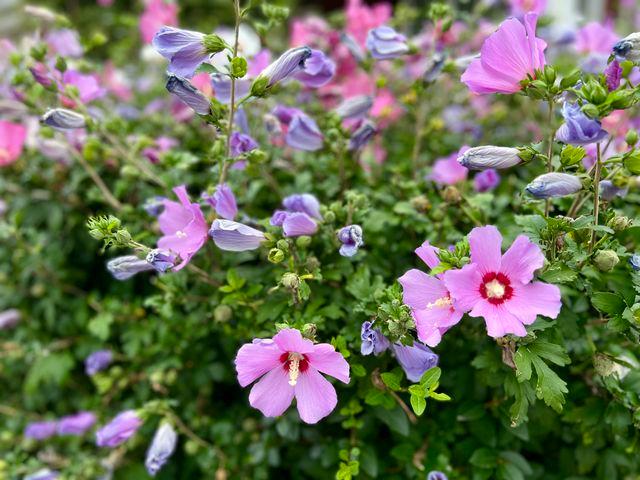
Botanical Name: Hibiscus syriacus
Sun Exposure: Full sun to part shade
Soil Type: Medium, well-draining, average fertility
Soil pH: Acidic to slightly alkaline (5.0-8.0)
USDA Hardiness Zones: 5 to 8
Rose of Sharon is a prolific bloomer, flowering June through October to the delight of butterflies, hummingbirds, and bees. The large tropical-looking blooms range in color from white to pink to purple, often with a contrasting eye. Plants display vigorous upright growth and produce a charming vase-shaped canopy. Rose of Sharon is heat and drought tolerant once established. Plants make an excellent addition to foundation plantings and shrub borders.
Meadowsweet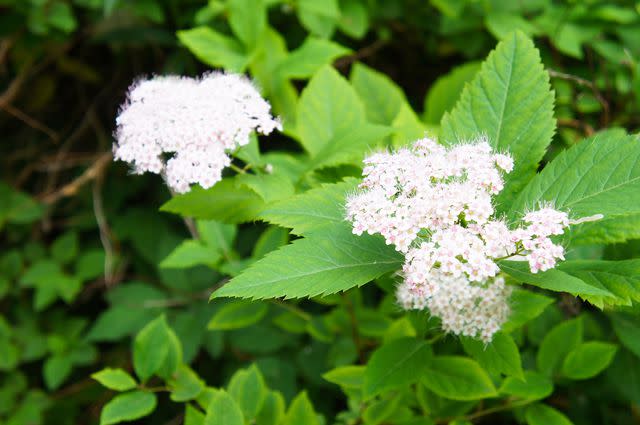
skymoon13 / Getty Images
Botanical Name: Spiraea japonica
Soil Type: Medium, well-draining, average
Soil pH: Adaptable (6.0-8.0)
USDA Hardiness Zones: 3 to 8
Meadowsweet, or spirea, is a graceful shrub with small oval leaves and dense branching. Plants grow in rounded to spreading mounds with the lowest branches hugging the ground. Many cultivated varieties are available, with more compact growth than the species, improved flowering, and often colorful foliage. Showy pink blooms are held in flattened clusters above the foliage, attracting butterflies to the
garden.
Summersweet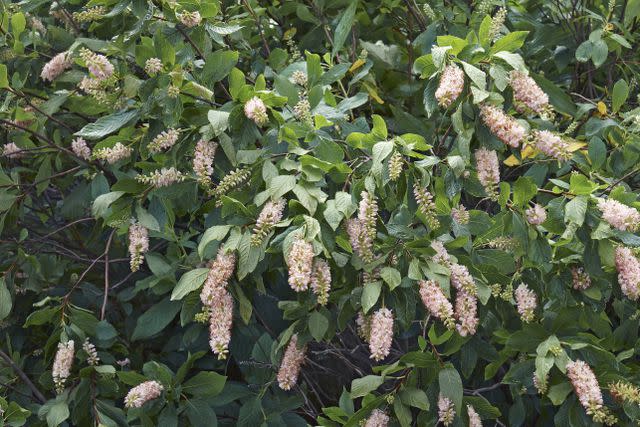
Botanical Name: Clethra alnifolia
Sun Exposure: Full sun to part shade
Soil Type: Moist, well-draining, rich
USDA Hardiness Zones: 4 to 9
Summersweet is a native deciduous shrub found in moist woodlands, along stream banks, and in seashore habitats throughout the eastern coastal states. They bloom well in both sunny and shaded sites, producing long spikes of fragrant white to pink blooms in late summer when little else is flowering. Blooms provide an excellent source of nectar for hummingbirds, butterflies, and native bees. Plant in a location where you can enjoy the sweet perfume.
Snow Joey® Viburnum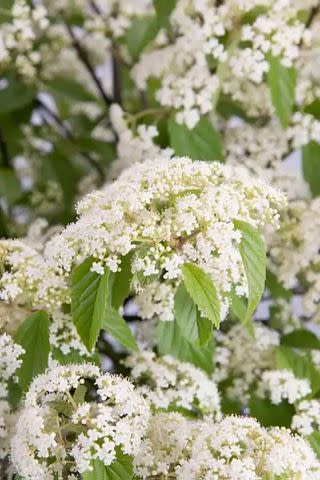
Southern Living Plant Collection
Botanical Name: Viburnum luzonicum ‘BLV01’
Sun Exposure: Full sun to part shade
Soil Type: Medium, well-draining, rich
Soil pH: Acidic (5.5 – 6.5)
USDA Hardiness Zones: 7 to 9
This uncommon viburnum provides season after season of color and texture, from lacy spring blooms to rich jewel-toned fall color. Bright red berries feed hungry songbirds in autumn while spring blooms lure pollinators. Snow Joey® is a compact selection, producing a dense, mounded crown that matures to six feet. Plants are pest free and drought tolerant once established.
Heart Throb® Hydrangea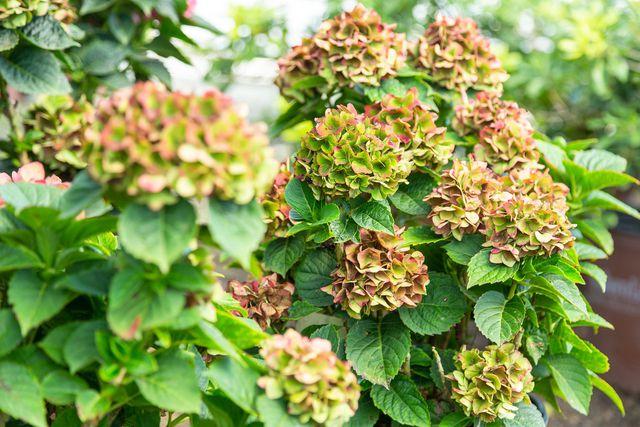
Southern Living Plant Collection
Botanical Name: Hydrangea macrophylla ‘Hortmagitri’
Sun Exposure: Part shade to shade
Soil Type: Medium, well-draining, rich
Soil pH: Adaptable (6.0-8.0)
USDA Hardiness Zones: 5 to 9
This stunning bigleaf hydrangea boasts dark red blooms, a color not commonly found among hydrangeas. Plants flower on both old and new wood, producing two flushes of blooms with immense staying power. Flowers age to green with hints of red, carrying color and texture into autumn. Heart Throb® is a compact grower, producing a tidy mound of foliage growing just three feet tall and wide. Plants display excellent disease and pest resistance.
Bluebeard
Botanical Name: Caryopteris hybrids
Soil Type: Medium, well-draining, average
Soil pH: Adaptable (6.0-8.0)
USDA Hardiness Zones: 5 to 9
Often called blue mist for their airy clouds of late summer blooms, bluebeard is a deciduous perennial that behaves like a shrub in warmer reaches of its range. In zones 7 and colder, the top growth of bluebeard dies back in winter, and most gardeners cut plants to the ground in spring. Plants bloom on new growth, so spring pruning does not impact flower production. Plants flower over a long season, supporting butterflies and native bees well into autumn.
Weigela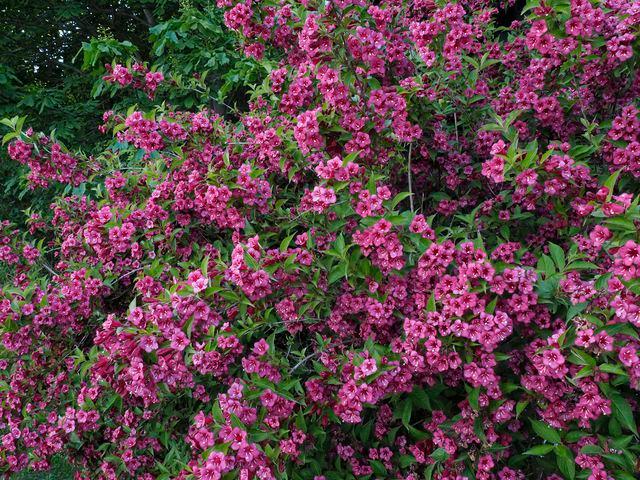
Botanical Name: Weigela florida
Soil Type: Medium, well-draining, average
Soil pH: Adaptable (6.0-8.0)
USDA Hardiness Zones: 4 to 8
Flowering for several weeks from late spring into early summer, weigela attracts hummingbirds to the garden with its showy, trumpet-shaped pink to burgundy blooms. This deciduous shrub grows upright to rounded, with branches arching toward the ground on mature plants. Numerous named cultivars are available including many varieties with variegated or colorful foliage and flower colors ranging from traditional pink to red, purple, and even yellow. This adaptable plant is excellent for massing in beds and borders.
Virginia Sweetspire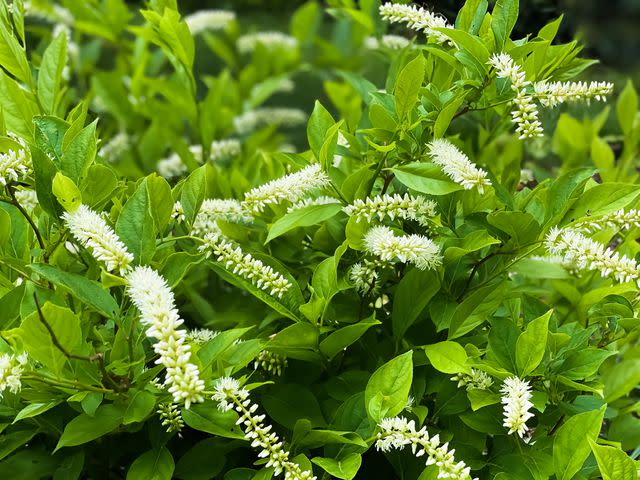
Botanical Name: Itea virginica
Sun Exposure: Full sun to part shade
Soil Type: Medium to moist, well-draining, average
Soil pH: Adaptable (6.0-8.0)
USDA Hardiness Zones: 5 to 9
This Southeastern native is adored for its slender, bottlebrush-like flower clusters that dangle from branches and envelop the garden in sweet perfume. Butterflies and other pollinators frequent the white blooms, which mature into copper-colored berries eaten by songbirds. Plants tolerate periods of standing water as well as drought, making a good selection for raingardens, along with more traditional uses.
Read the original article on Southern Living

